#uruguayan air force flight 571
Text
why I'm happysad that they let Numa be the narrator in Society of the Snow.
So if you, like me, have been more than a little obsessed with the story of Uruguayan Air Force Flight 571 for a very, very long time, your stomach probably dropped like mine did when the narrator introduced himself as Numa Turcatti. (My immediate thought was, "why would you do this to us?!") If you went in blind, I feel for you!
But while the film gave us a version of Numa, since it's from his perspective what it doesn't really give us is the group's perspective on him. He comes across a bit like an outsider, and although, yes, his only surviving friend was Pancho Delgado, he wasn’t an outsider for long at all. On the contrary. So, here are a few excerpts from the books that tell you more about what he was like and how much they all loved him, because I feel like that’s important.
From Alive, Piers Paul Read:
Next to Parrado, Numa Turcatti was the most generally beloved of the boys. [...] Since he had known few of the boys before leaving Montevideo, it was proof of his strength, simplicity and complete lack of malice that he became so loved and respected by them.
On celebrating Numa's birthday while trapped under the avalanche:
The boys gave him an extra cigarette and made a birthday cake out of snow. [...] Many would have liked to give him a better time on his birthday, but instead it was he who improved their spirits. "We have survived the worst," he said. "From now on, things can only get better."
From Society of the Snow, Pablo Vierci:
‘When I talk about Numa, I can’t help but cry,’ says Coche Inciarte. ‘He’s the best person I’ve ever met in my life. However tenderly I cared for those who were losing heart, Numa did it much better because he never got tired. He was constantly aware of everyone else’s distress. He radiated peace, he never gave up, and when he came near me, I felt like Jesus Christ himself was among us, with such mercy and compassion in his eyes. I don’t know where he got his strength.’
‘I could never imagine him living in everyday life, because I met him and I loved him in that torment of the Andes,’ says Coche. ‘He had a hard time eating, like I did. We ate the bare minimum in order to survive. I lost one hundred pounds, he lost more. And just like me, his leg became infected after the avalanche. We operated on our legs together with a razor blade. But he deteriorated more quickly than I did, because he had given so much more; he had been too generous.’
Moncho Sabella:
Numa taught us about the anonymous heroism of giving more of himself to others than he reserved for himself. In that balance between solidarity and selfishness, which decided whether you lived or died, he tilted the balance in favour of the others to the detriment of himself. [...] And when the avalanche came and covered the plane, the one who worked the hardest, the one who removed the most snow so that we could come back to life, was Numa. Again, he was exceeding his own limits. [...] In the end, his immune system was so devastated that he got one infection after another. We gave him antibiotics and the doctors on the mountain attended to him every day, but finally he left us. And with him, we all died a little more.
Gustavo Zerbino:
I always remember Numa up there, full of despair, when he told us that he would rather die watching the sky, walking, instead of ending life immobilised in a cave of broken metal. For that reason, after the avalanche, he kept digging and removing snow without rest until he burned himself out with exhaustion. He always thought that his time had come but he wanted to work until the final moment, doing whatever he could to help. I cared for him all those days; I saw how he was hurried to the brink of death, with no defences, getting one infection after another. I went up to him and first I gave him a kiss on the cheek to greet him and asked him how he was doing. He just stared at me with a kind of infinite peace. He never complained. But Numa was quickly deteriorating: from that physical strength and vigour he had had at the beginning, he finished as a skeletal dying boy. He held on to his characteristic qualities until the end though. He was that same stoic guy when he was strong and when he was wasting away.
‘Gustavo Zerbino didn’t tell us the whole truth [about the expedition] because he didn’t want us to be discouraged. When I asked Numa about it, he couldn’t lie and he told me: “As far as we went, all you could see were more mountains.” But even so, he always wanted to be an expeditionary. “I want to go,” he told me, even though I knew at once he could never go, he was too exhausted and too hurt.’ So Numa approached Daniel Fernández, knowing that he had influence over the others, and he tried to convince him: ‘I can do it, Daniel, please believe me. I can do it.’ Daniel recalls, ‘When I told him that his injury made it impossible, he started working even harder than ever, like a bull, shovelling snow to unbury the plane after the avalanche to show that yes, he could do it.’
Finally, from Alive, after Numa died:
On this particular afternoon, Javier Methol lay at the back of the plane. "Be careful," he said to Coche as he rose and stepped over Numa's body. "Be careful not to step on Numa."
"But Numa's dead," said Parrado.
Javier had not realised what had happened, and now that he understood his spirits dropped completely. He wept as he had wept at the death of Liliana, for he had grown to love the shy and simple Numa Turcatti as though he were his brother or son.
I'm not sure the Numa we see in the film is quite the same person that he actually was on that mountain, but I'm so, so glad that he got a voice. He fought so hard for them all.
So, yeah. In the immortal words of Jake Peralta,

209 notes
·
View notes
Text

With all the death and avalanches and starvation and cannibalism I sometimes forget just how young these guys were. And then I get blasted with something like this.
#non fiction#alive the story of the andes survivors#roberto canessa#nando parrado#uruguayan air force flight 571#miracle in the andes#iphi.post#bookblr#words words words#booklr#20y/os gonna 20y/o i guess
67 notes
·
View notes
Text
What is the “Miracle in the Andes”?
On October 12th 1972, a Fairchild FH-227D left Carrasco International Airport in Montevideo headed towards Chile. It was the Uruguayan Air Force Flight 571, chartered by an amateur rugby team called Old Christians. The plane carried 40 passengers and 5 crew members. Among the passengers were members of the team and a few of their friends and family.
The purpose of the trip was to play a friendly rugby match against a local team plus a short vacation of a few days in Santiago. Friends and family were brought along in order to fill the remaining seats on the plane, so that each ticket could be sold at a more affordable price.
As it turned out, the Fairchild would never reach its destination. After an unplanned layover in Mendoza, at the foothills of the Andes on the far west of Argentina, the plane departed for Santiago in the early hours of the afternoon of Friday 13th.
Caught in the middle of thick clouds and strong winds, the pilots miscalculated their position and began to descend when the plane had yet to cross the mountains, some of which were over 15.000 feet high.
The right wing crashed against a peak, severing the fuselage in the process. Subsequently, the same thing happened to the left wing. A handful of passengers and two members of the crew fell off the back of the plane and disappeared in the mountains.

photo taken inside the plane before the disaster
What remained of the fuselage slid down the mountainside at just the perfect angle so as to not come undone in a million pieces. When it came to an abrupt stop, passengers were violently thrown to the front of the plane still attached to their seats. Several more died, some crushed instantly and others a few minutes or hours later due to their injuries.
Sixteen of those that remained beat all odds and survived for 72 days in the freezing cold with no food or water. This blog aims to share information about what is undoubtedly the greatest survival story of all time.
46 notes
·
View notes
Note
If you were stranded, like a Donner party situation. How would you prepare the poor schmuck who drew the short straw?
Real answer? Wait for them to die first. I've long been of the opinion that if I'm ever trapped in a Donner Party/Flight 571 situation, I'd give my fellow survivors permission to eat me after I died. I'm not using it anymore, they need it more than me. As morbid as it sounds, I want to establish this promise up front so nobody has to hem and haw over the morality of it as they slowly starve to death in the snow. I'm not gonna kill anyone for food, but if we came to an agreement before hand and they died early, then it's fair game. I never want someone to say "this is what he would have wanted" unless it is in fact what I would have wanted. If I die, eat me. Those Uruguayan rugby players were stranded in the Andes for ten weeks. The government search was called off early. Their parents were seeking the advice of psychic scam artists to find them. They had to make a difficult decision, and it ended up saving 16 lives. Nobody wants to think about this because it's very unlikely to ever happen, but for the poor few who find themselves in this situation I feel it would save a lot of time and stress to let it be known from the start that there's no shame in it, especially after all other options have been reasonably exhausted. You can only subsist on leather, seat cushions, toothpaste and lipstick for so long. It's not something to be enthusiastic about, but if it's the last resort, you do what you gotta do to survive, and no one can judge you for that.
26 notes
·
View notes
Text


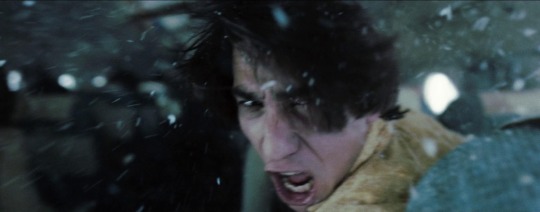

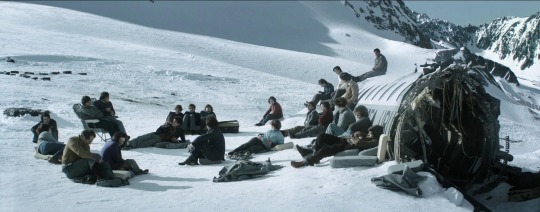



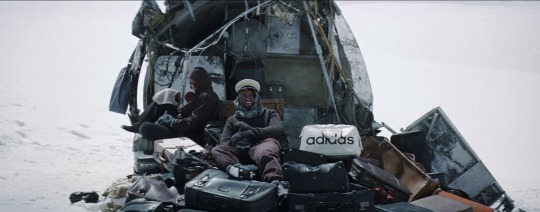

Society of the Snow (2023)
dir. J. A. Bayona
#society of the snow#j. a. bayona#films#cinema#film aesthetic#film stills#cinematography#movies#2023#uruguayan air force flight 571#uruguay
6 notes
·
View notes
Text
Canessa's voice when he was younger was so....
*cries in adoration*
#he was only 19 here...#flight 571#dr roberto canessa#roberto canessa#uruguayan air force flight 571#1972
5 notes
·
View notes
Link
Uruguayan Air Force Flight 571 was the chartered flight of a Fairchild FH-227D from Montevideo, Uruguay, to Santiago, Chile, that crashed in the Andes mountains on 13 October 1972. The accident and subsequent survival became known as the Andes flight disaster (Tragedia de los Andes, literally Tragedy of the Andes) and the Miracle of the Andes (Milagro de los Andes).
The inexperienced co-pilot, Lieutenant-Colonel Dante Héctor Lagurara, was piloting the aircraft at the time of the accident. He mistakenly believed the aircraft had overflown Curicó, the turning point to fly north, and began descending towards what he thought was Pudahuel Airport in Santiago de Chile. He failed to notice that instrument readings indicated he was still 60–69 km (37–43 mi) east of Curicó. Lagurara, upon regaining visual flight conditions, saw the mountain and unsuccessfully tried to gain altitude. The aircraft struck a mountain ridge, shearing off both wings and the tail cone. The remaining portion of the fuselage slid down a glacier at an estimated 350 km/h (220 mph), descending 725 metres (2,379 ft) before ramming into an ice and snow mound.
The flight was carrying 45 passengers and crew, including 19 members of the Old Christians Club rugby union team, along with their families, supporters and friends. Three crew members and nine passengers died immediately and several more died soon after due to the frigid temperatures and the severity of their injuries. The crash site is located at an elevation of 3,570 metres (11,710 ft) in the remote Andes mountains of western Argentina, just east of the border with Chile. Search and rescue aircraft overflew the crash site several times during the following days, but failed to see the white fuselage against the snow. Search efforts were called off after eight days of searching.[1]
During the 72 days following the crash, the survivors suffered from extreme hardships, including exposure, starvation and an avalanche, which led to the deaths of 13 more passengers. The remaining passengers resorted to cannibalism to survive. As the weather improved towards the end of the spring, two survivors, Nando Parrado and Roberto Canessa, climbed the 4,650-metre (15,260 ft) mountain peak on the western rim of the glacier cirque without any mountaineering gear. They hiked for 10 days into Chile, traveling 61 kilometres (38 mi), before finding help. On 22 and 23 December 1972, two and a half months after the crash, the 14 remaining survivors were rescued.
#uruguayan air force flight 571#andes flight disaster#the miracle of the andes#aircraft accidents#aviation#cannibalism
0 notes
Link
Our survival correspondent Blair Braverman is here to tell us the story of Uruguayan Air Force Flight 571, which crashed in the Andes on October 13, 1972. Of the 45 people on board, 16 ultimately lived. Their survival made them heroes, until the way they survived shocked the world. This week, a story of glaciers, peanuts, and friendship.
Here's where to find Blair:
Website
Twitter
Small Game [book]
#Flight 571: Survival in the Andes with Blair Braverman#you're wrong about#Alive#true crime#plane crash#Blair Braverman#Uruguayan Air Force Flight 571#andes mountains#south america#uruguay#chile#1970s#books and reading#books and authors#podcast#podcasts
1 note
·
View note
Text
So given the writer’s strike, some people are concerned about their shows and movies being postponed or canceled, and aside from the fact networks have already BEEN canceling shows for no reason for years (I still maintain a healthy anger about what Netflix did to Sense8), I thought I would suggest some books on disasters you might want to read if you’re into that sort of history. Which you are if you’re here, I imagine.
Note: I’m suggesting these books because most books on disasters don’t get a huge audience, and so I recommend them because this sort of writing can be hard on the writer and requires a bunch of research. We throw so much money at true crime, we can spare a few bucks for the stories of people who died in disasters.
Also, please check with these with your local small bookstore or library. Amazon can be great, but let’s lend a hand to those who need us more.
Recommended books:
“The Circus Fire,” by Stewart O’Nan - This is one my favorite books on a disaster, because the whole thing creates a very vivid image of the circus prior to the fire in Hartford in July of 1944. There’s one specific line in the book which always makes me pause because it’s so affecting, about how everyone who escaped being able to hear the sounds of the animals screaming as they died - except all of the animals were out of the tent by then.
“The Only Plane in the Sky,” by Garrett Graff - This, I highly recommend you get on audiobook. It’s an oral history of the events of 9/11 with a full cast, and it’s incredibly affecting to listen to.
“Ada Blackjack: A True Story of Survival in the Arctic,” by Jennifer Niven - Ada Blackjack was a badass: flawed and weak at times, but hardy and steady when necessary. Half of her story is how she survived, but half is how she was exploited following her rescue. Both stories need to be known.
“Alive,” by Piers Paul Read - If you’re watching “Yellowjackets,” this should be required reading. If you’ve seen the movie adaptation from the 90s, there is WAY more you don’t know. The story of Uruguayan Air Force Flight 571 is a tough read, but a worthy one.
“A Night to Remember,” by Walter Lord - This is to disaster nonfiction what “In Cold Blood” is to true crime. It’s not a long read, but it’s a great one. Lord had the advantage of writing the book while many of the Titanic survivors were still alive and could give a very good description of what they went through.
“Dying to Cross,” by Jorge Ramos - I recommend this not just because it is good, but because it is timely. Nineteen people died in an un-air-conditioned truck as they were attempting to make their way into the states from over the Mexican border. It’s a horrific story, and one that humanizes an issue for whom some people need to be faced with the humans involved and what they go through.
“Bath Massacre: America’s First School Bombing,” by Arnie Bernstein - Harold Schecter also wrote a very good book on the Bath school massacre called “Maniac,” but I have a preference for this version. It’s a good reminder that schools in the U.S. didn’t just become targets in the last twenty years or so.
“Into Thin Air,” by Jon Krakauer - I feel like this is a gimme, but it’s a fantastic book from someone who was actually on Mount Everest during the 1996 disaster and knew those involved very well. I happen to like Krakauer’s work anyway - I even like “Into the Wild” despite my feelings about McCandless and his legacy - but it’s understandably my favorite.
“And the Band Played On,” by Randy Shilts - The one thing I will say is that Shilts’ treatment of Gaetan Dugas is *rough* to say the least and outright wrong on some points, God knows. But it’s still an amazing book, and if you come out of it not wanting to dig up Reagan and punch him a bunch I’m impressed at your restraint.
“Triangle: The Fire That Changed America,” by David von Drehle - The Triangle Shirtwaist Factory Fire is one of the disasters I am most interested in, and I would argue this is the definitive book on the subject. Also, if this book introduces you to both Clara Lemlich and Frances Perkins … I mean, talk about badass women.
“The Radium Girls,” by Kate Moore - Look, I’ll say this. If you know of the Radium Girls, this is a great book on their story. If you don’t know, go in blind and prepared to be horrified.
“Red Famine: Stalin’s War on Ukraine,” by Anne Applebaum - Ukraine has always been a target. During the Holodomor, they were victims of one of the worst genocides in history.
“Midnight in Chernobyl,” by Adam Higginbotham - Like the miniseries? This is a great source for more information for what happened at Chernobyl and all of the ass-covering involved.
"Boston Strong: A City's Triumph Over Tragedy," by Casey Sherman and Dave Wedge - If you’re interested in the Boston marathon bombing, I really thought this book did a good job of connecting the stories of the victims, the authorities searching for the killers, and the killers themselves.
“Show Me the Bodies: How We Let Grenfell Tower,” by Peter Apps - As I understand it, Apps did a lot of covering the Grenfell Tower fire for the British press, and it shows. He provides a mountain of information, and you will come out of reading this book absolutely LIVID about what authorities allowed to happen in Grenfell and so many other council estates in the UK.
“Dark Tide: The Great Molasses Flood of 1919,” by Stephen Puleo - I feel as though the molasses flood gets treated like a joke a lot of the time, but y’all, twenty people died. That area of Boston was *wrecked*. The photos of the devastation are terrifying. Puleo treats all of this with the proper respect it deserves.
“In the Heart of the Sea: The Tragedy of the Whaleship Essex,” by Nathaniel Philbrick - Forget the movie. Read the book.
“The Great Influenza,” by John M. Barry - Want to read about the 1918 flu epidemic? Want to be mad that a hundred years later we didn’t learn a damn thing?
Now, that’s just a start. If anyone wants, I can always post photos of my disaster book collection on Kindle and next to my recording desk. Or if there’s a specific disaster you’re interested in, I may know of a good book about it you can read.
But just remember if SAG and the directors’ guild joins the strike too - there is so much out there to occupy your time until they come back. Entertainment work is work, and it deserves to be supported financially and fairly as such. Rock on, WGA. ✊
433 notes
·
View notes
Text
List 5 topics you can talk on for an hour without preparing any material.
Thank you for tagging me @the-20th-century-girl!
1. Palaeontology: I didn't get a PhD for nothing and even though it's been years since my thesis defense, I'm sure I could still do the full presentation without preparation. I dedicated three years of my life to this (ten if you count my bachelor's and master's degrees as well) and I certainly don't mind talking about this childhood dream of mine or the issues surrounding academia, especially here in Germany.
2. Ghosts and anything Six Idiots related: the Six Idiots have been such a huge part of my life for the last few years even my family now knows who I'm talking about when I mention Thomas lol. They're lucky the original Ghosts isn't on TV here or I definitely would have made them watch it with me (on that note, I made my dad watch Bill last year and he enjoyed it!).
3. The Lord of the Rings: the films and then the books changed my life 23 years ago and if prompted, I will happily discuss why the Eagles were not the solution to the ring problem and why the Silmarillion is absolutely incredible and not dry and boring at all. Oh, and don't get me started on the musical or I will lament for an hour about the Springle Ring not being on the cast recording.
4. Survival stories: Uruguayan Air Force Flight 571 is just the latest in a line of survival stories that I have been fascinated by over the years. I'm sure I could talk about it for an hour alone but there's also the Franklin Expedition, the Donner Party, the Endurance Expedition, the Terra Nova Expedition, the Batavia shipwreck ... I think you get my point. There is just something about humans facing such extremes adversities and, if they're lucky, rising above them that I find deeply touching.
5. Animals in captivity: a few years ago, the documentary Blackfish opened my eyes to all the issues surrounding animals in captivity. I will never forget the pictures of Orca teeth being so far eroded that you can see the root canal or that one time my palaeo prof took one look at a skeleton and promptly asked if the specimen came from a zoo because he could immediately tell by the deformed bones and worn teeth. I don't try to convince people not to go to zoos because it's none of my business to tell them how to live their lives but if asked I do tell them why I don't visit those places anymore in the hopes that they too will realise that a fun day out for them is a lifetime of miserable imprisonment for the animals they claim to love.
Honorable mention goes to History because I have been fascinated by a wide range of historical topics over the years (the Pacific theatre of war, Chernobyl and nuclear power, the Plague, Napoleonic Wars, Ancient Rome, mountaineering history, medical history ...) and could talk about any of them for hours if prompted.
Tagging @amalthea9, @professorlehnsherr-almashy and @ginevralinton but no pressure!
49 notes
·
View notes
Text
Gustavo Zerbino, guardian of memories
Gustavo's chapter is one of my favourite things about Vierci's Society of the Snow, and every time I read this part it rips my heart out.
I handed a piece of paper to Sergio, who was with the medic José Bravo, paper which I had torn out of a notebook where I wrote down the names of each person who had died, indicating the corresponding pile of bones for each name. I acquainted the mountaineers with the remains of all of them, so that if at some future date their relatives came here, each one would be able to find the remains of their son and take him home if they wanted. Sergio stared at me as though I had lost my senses. I was with them for two hours at the nose of the plane with that paper, explaining everything to them. I wanted someone else to know. [...] I knew that Nando’s mother and sister were on this side, along with Liliana Methol. I knew that for two reasons: because they might be food tomorrow and, if we were to get out alive, their families could take them back to Montevideo if they wished. I knew who was here, who was there, who was in between, each scattered in his own place.
Sergio Díaz took my hand and said, ‘Thank you, thank you, Gustavo, but it doesn’t matter, it’s over, and you don’t need to worry any longer.’ He wanted to protect me, but I wanted to protect my friends.
#society of the snow#pablo vierci#gustavo zerbino#miracle in the andes#uruguayan air force flight 571
28 notes
·
View notes
Text
The full passenger manifest of Uruguayan Air Force Flight 571, which set off from Montevido, Uruguay to Santiago, Chile, on October 12th, 1972.
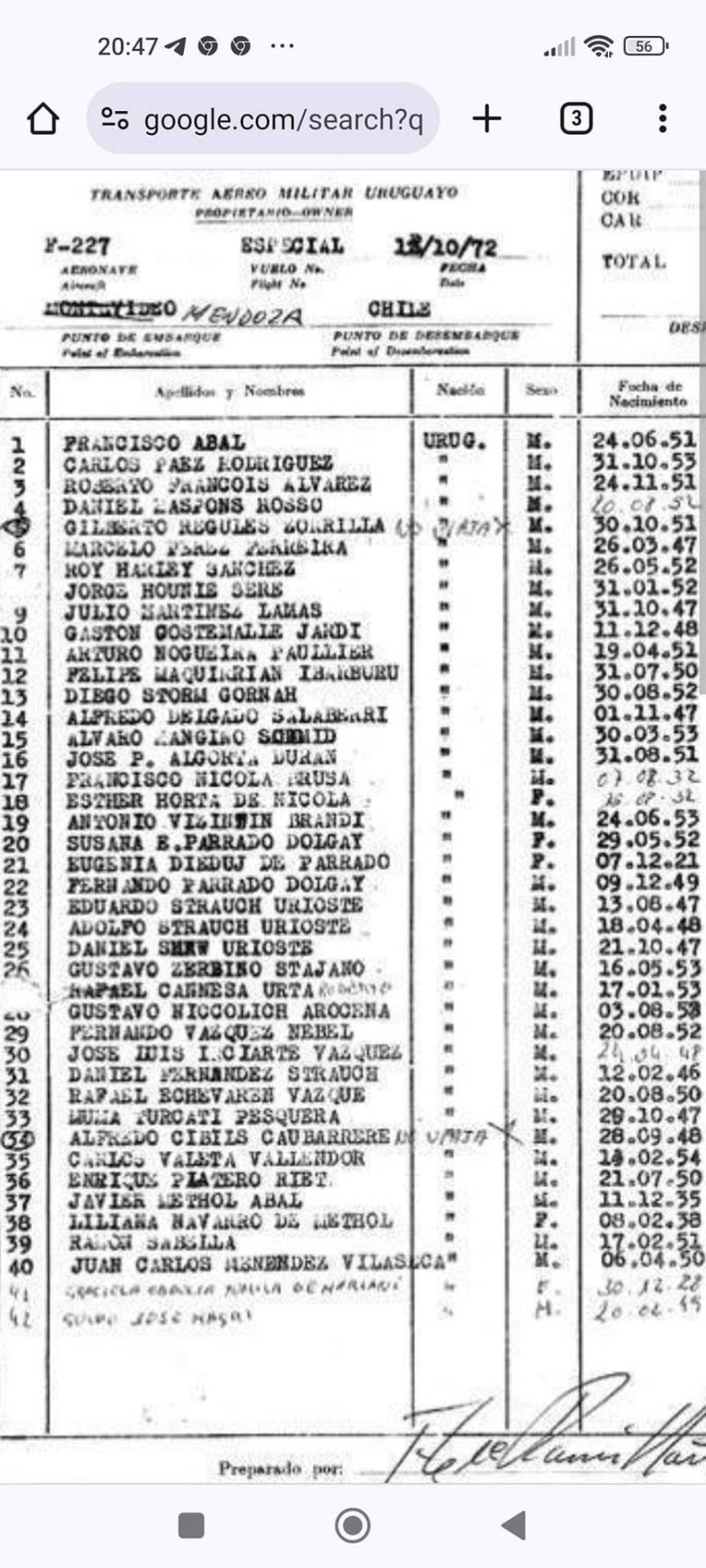
1. Francisco Abal
2. Carlos Paez Rodriguez
3. Roberto Francois Alvarez
4. Daniel Maspons Hossa
5. Gilberto Regules Zorrilla
6. Marcelo Pérez del Castillo
7. Roy Harley Sanchez
8. Jorge Hounie Sere
9. Julio Martinez Lamas
10. Gaston Costemalle Jardi
11. Arturo Nogueira Paullier
12. Felipe Maquirriain
13. Diego Storm Gornah
14. Alfredo Delgado
15. Alvaro Mangino
16. Jose P. Algorta Duran
17. Francisco Nicola Brusa
18. Esther Horta de Nicola
19. Antonio Vizintin Brandi
20. Susanna E. Parrado Dolgay
21. Eugenia Dolgay de Parrado
22. Fernando Parrado Dolgay
23. Eduardo Strauch Urioste
24. Adolfo Strauch Urioste
25. Daniel Shaw Urioste
26. Gustavo Zerbino Stajano
27. Roberto Canessa Urta
28. Gustavo Nicholich Arocena
29. Fernando Vasquez Nerel
30. Jose Luis Inciarte Vasquez
31. Daniel Fernandez Strauch
32. Rafael Echavarren Vasque
33. Numa Turcatti Pesquera
34. Alfredo Cibils
35. Carlos Valeta Vallendor
36. Enrique Platero Riet
37. Javier Methol Abal
38. Liliana Navarro de Methol
39. Ramon Sabella
40. Juan Carlos Menendez Vilascca
41. Graciela Obdulia Augusto Gumila de Mariani
42. Guido Jose Magri
#flight 571#Uruguayan flight 571#miracle in the andes#el milagro de los andes#history#history posts#passenger manifest#survival stories#disaster stories
14 notes
·
View notes
Text
51 years ago, the Uruguayan Air Force Flight 571 crashed in the middle of the Andes.
Here are some pictures taken by the survivors during the ordeal, with a camera found in the wreckage.
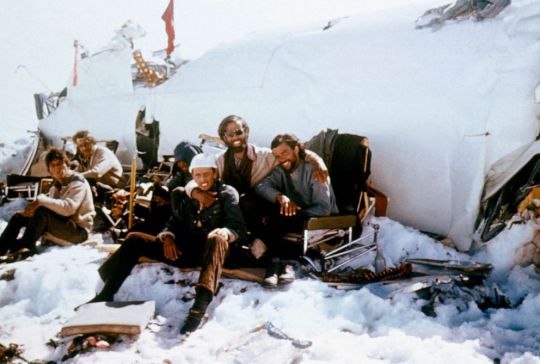
from left to right: Alvaro Mangino, Moncho Sabella, Numa Turcatti (deceased), Daniel Fernandez, Coche Inciarte and Pancho Delgado.

from left to right: Javier Methol, Coche Inciarte, Roy Harley, Pancho Delgado, Nando Parrado (red beanie), Numa Turcatti, (not sure about the guy in white with his back to the camera or the guy with a grey cloth on his head), Bobby François, ?, ?, Carlitos Paez (shirtless).
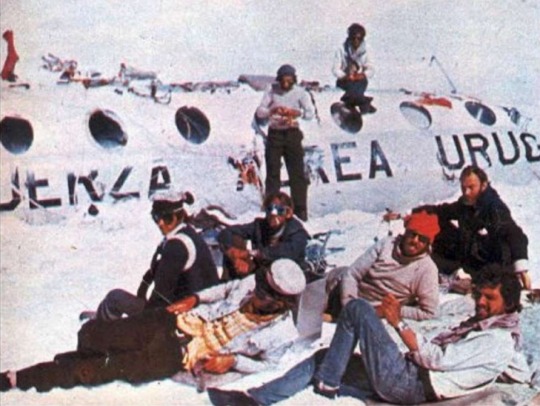
front row: Fito Strauch and Carlitos Paez
second row: Gustavo Zerbino, Eduardo Strauch, Nando Parrado and Javier Methol
standing: Roberto Canessa
on top of the plane: Pancho Delgado

another angle
#andes plane crash#miracle in the andes#plane crash#uruguayan air force flight 571#los andes#andes tragedy
27 notes
·
View notes
Text
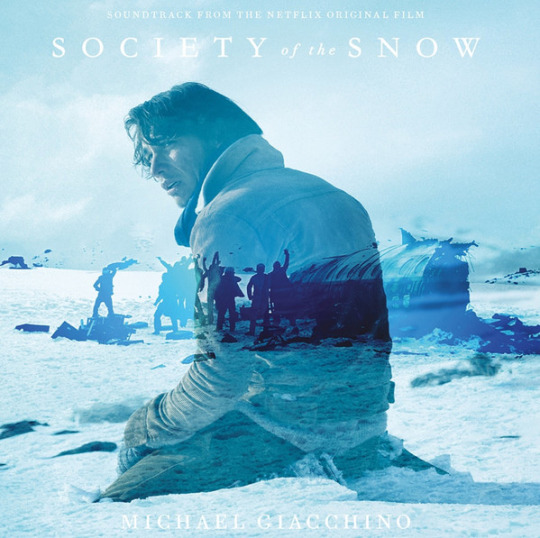
Society of the Snow ❄️
The 96th Academy Awards are upon us, with the 2024 Oscars taking place this weekend on Sunday, 10th March 2024 · Society of the Snow has been nominated for two Oscars, for Best International Feature Film, Not in the English Language as well as the best makeup and hairstyling. Society of the Snow became the third-most-prized film in Goya history after winning 12 awards at Spain's Goya Awards and winning a European Film Award but the interest is not just for the awards but for the true story behind this film/Thriller/Adventure documentary.
Directed by Juan Antonio García Bayona, the Spanish-language film is about the 1972 plane crash that stranded dozens of people–most notably players of an Uruguayan rugby team–on a glacier in the Andes. But it was Pablo Vierci’s Society of the Snow, a non-fiction account of the disaster, published in 2008 and made with the full collaboration of the survivors and their families, that caught Bayona’s interest. The film is an adaptation of Pablo Vierci’s book. The cast is composed of Uruguayan and Argentine actors, most of whom are newcomers.

In case you have no idea about this film, please, let me explain: The rugby world knows very little about this story, so after watching the Rugby World Cup in France last year 2023 and seeing the resilience of the Uruguayan rugby team in the World Cup, I watched the film and read books getting more and more interested in the subject. The Snow Society tells the true story of Uruguayan Air Force Flight 571, a plane that crashed in the Andes in 1972, leaving a rugby team and its fans hungry and stranded for 72 days. There were 45 people on the flight, 40 passengers and 5 crew members. 19 of the passengers were members of the Old Christians Club rugby team.

Old Christians Club, or simply Old Christians, is a Uruguayan sports club from Carrasco, it is a neighbourhood of Montevideo. The club is known mostly for its rugby union team which became famous around the world due to the Uruguayan Air Force Flight 571 crash that involved the first division team of the club in 1972. Old Christians amateur rugby team charted a Uruguayan Air Force plane to transport the team's players, friends, fans and family members to Santiago, Chile, for an exhibition match.

It is Highlighted by one of the better plane crash scenes put to film in quite some time, Bayona, who also directed The Impossible (the criminally underseen survival pic about the extremely deadly 2004 tsunami), treats the audience to an immersive, detailed, and gritty look at how the young men who were eventually rescued from the icy slopes survived for nearly two months.
That's been dramatised many times before, most notably in 1993’s “Alive”, starring Ethan Hawke, but the director J. A. Bayona’s rendition may be the most immersive take yet.
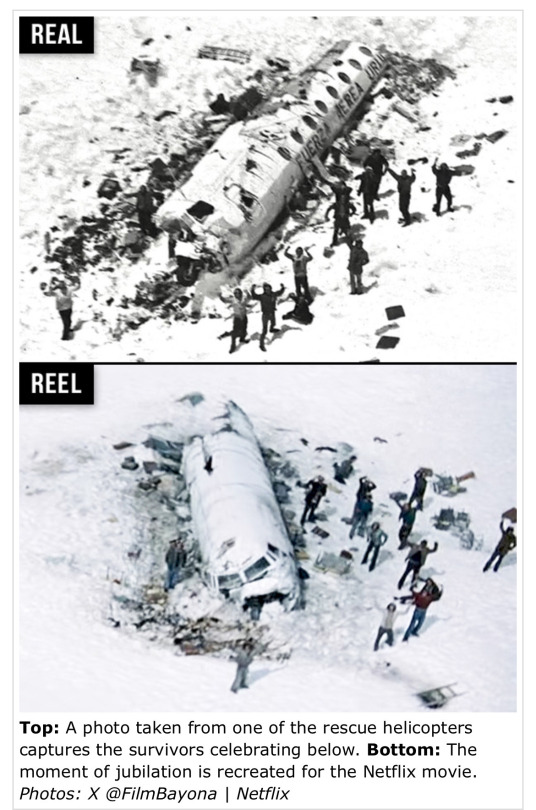
The crash scene is meticulously re-created—people being sucked out of the fuselage, bones shattering as the seats get ripped from the floor, bodies crumpling toward the cockpit. Most of the film takes place on the mountain range’s blinding snow-covered slopes, the victims’ skin bluish with frostbite, and the sound of howling winds incessantly. Almost every shot highlights the frigid, terrifying reality of what happened.
In my opinion, J.A.G. Bayona did an incredible job directing the film because I felt their stress and desperation, their fear and hope, and I feel this is one of those films that are a complete experience, one of those that makes you value everything you have and open your eyes. It’s a gruesome tale —the survivors eventually resorted to cannibalism— The survivors (and the not-lucky ones) became a life inspiration.
They wanted to live, they dreamed of living, they fought to live, they did EVERYTHING and more to achieve success, and thanks to those guts they wrote their story.

Society of the Snow is the Definitive Account of the World’s Greatest Survival Story. Waiting for a rescue team that didn't arrive, the survivors became fewer and fewer in numbers. Stranded alone on a glacier, they had to face brutal temperatures, lethal avalanches and the loss of friends and family with no access to supplies, food or water. In order to survive, they had to do the unthinkable. It wasn't until seventy-two days later that they were able to reach safety.
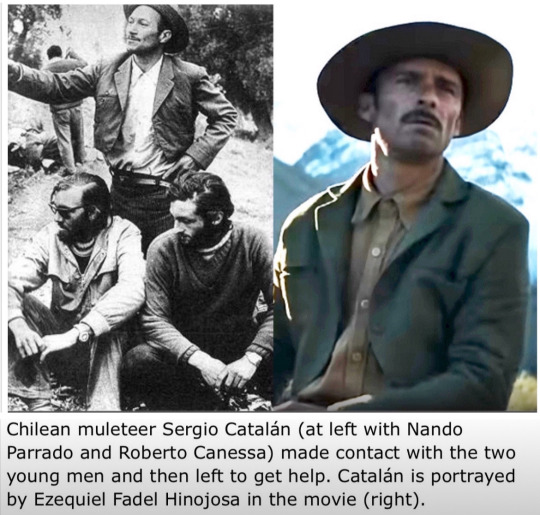
Eventually, two of the survivors – Nando Parrado and Roberto Canessa – were able to find help after embarking on an improbable hike into Chile, which took 10 days and saw them climb a 4,650-metre peak and travel 61km (37.9 miles) without any mountaineering gear.
Thanks to their efforts, the remaining team members were subsequently saved, and the incredible tale of survival became known as the Miracle of the Andes.
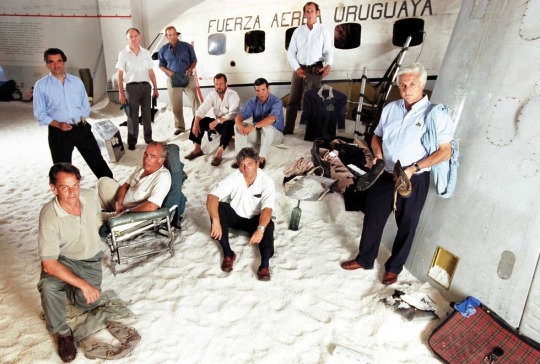
The Survivors- Sipa/Shutterstock
To increase the film’s realism, director J.A. Bayona decided to film footage at the actual crash site in the Andes, El Valle de las Lágrimas, which translates to The Valley of Tears (the name the location received after the tragedy in Chile).
The film's filming locations spanned the Catalan city of Terrassa, the rugged Sierra Nevada mountains in Spain, and the formidable Andes mountains, adding to the cinematic allure of the survival tale.

Society of the Snow appears to be a smash hit with both the critics and audiences, and is certainly one of the best Netflix films of recent times – it has a 90% Rotten Tomatoes score and 83% audience rating. If you haven't seen it yet, then I highly recommend you give it a go.
The Oscars are about to begin. The Dolby Theater in Los Angeles is already rolling out its red carpet.
youtube
#SocietyoftheSnow #JAGarcíaBayona #Director #96thAcademyAwards #Oscar #Spain #film #BestInternationalFeatureFilm #PabloVierci #Spain'sGoyaAwards #EuropeanFilmAward #Thriller #Adventure #documentary #Rugby #Uruguayanrugbyteam #Spanishlanguage#book #OldChristiansClubrugby #UruguayanAirForce #Flight57 #World’sGreatestSurvivalStory #MiracleoftheAndes
@brian-in-finance Yeah! Survivors of the Andes (1976) (Supervivientes de los Andes ) was a Mexican film directed by René Cardona, based on the 1973 book Survive! by Clay Blair, which is based on the story of Uruguayan Air Force Flight 571. The film received negative criticism, not a top budget film but still they could have put in a little more effort than what they did a very poorly done.
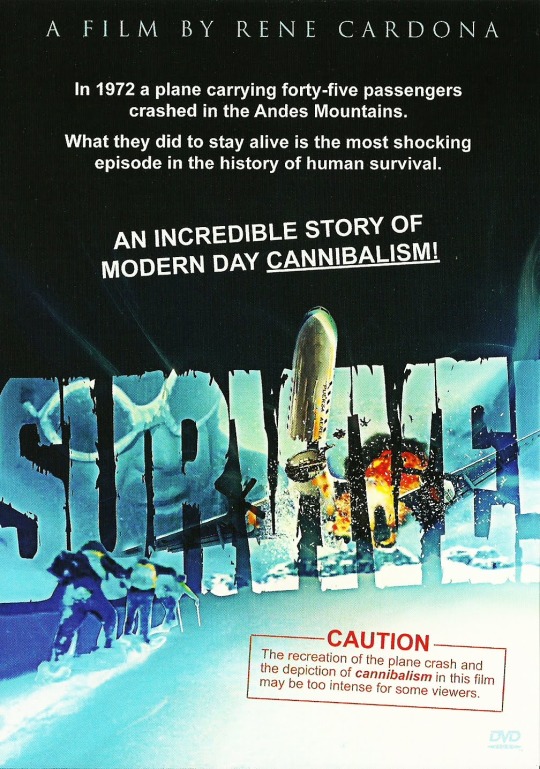
8 notes
·
View notes
Text
Society of the Snow Review
In 1972, a Uruguayan flight crashes in the remote heart of the Andes, forcing the survivors to become each other's best hope for survival, even resorting to the extremes to stay alive.
The saga of Uruguayan Air Force Flight 571, marked by tragedy and miracle, has found its way to the silver screen in various adaptations. While previous renditions often emphasized the spectacle of survival, “Society of the Snow” courageously delves into the horrors accompanying the miraculous event.
Internationally renowned as a miraculous tale of survival, the narrative unfolds as a tragic flight where the majority of passengers met instant death—either crushed or thrown into the unforgiving Andes Mountains. Soon the survivors, beginning to starve, resorted to cannibalism to stay alive. At one point, the survivors were buried under an avalanche for several days, which claimed the lives of several members. Then as the winter’s bite begins to thaw, two survivors made the treacherous journey across the Andes mountains to Chile, seeking rescuers for their fellow survivors.
Director J.A. Bayona fearlessly confronts the grim realities of this extraordinary event. The depiction of the plane crash is strikingly accurate and chilling, resonating with the sounds of crushing metal, shattering bones, and human screams. Bayona meticulously portrays the crash with all the terrifying details one can fathom. The horror intensifies as the survivors find themselves buried alive in the confining fuselage of the shattered aircraft for several days, subjected to multiple avalanches. Their muffled screams, stifled by the encroaching snow, evoke a profound sense of horror. The cinematography adeptly conveys the claustrophobic and uneasy atmosphere as the survivors endure their harrowing ordeal. Yet, when bathed in the radiant sunlight, the cinematography transforms into a beautiful yet desolate portrait of the haunting magnificence of the Andes Mountains. Despite this horrifying spectacle, it is not the center of this story.
At its core, "Society of the Snow" revolves around the indomitable human spirit's resilience in the face of adversity. The survivors, confronted by a relentless series of tragedies, remain steadfast in their mutual commitment to survival. Their awe-inspiring and powerful will to endure becomes a masterclass illustration, emphasizing that survival transcends mere physical strength and encompasses profound psychological resilience. Moreover, the film navigates the complex theme of cannibalism with utmost respect. It portrays the survivors grappling with their faith as they reluctantly engage in an act deemed unspeakable. The narrative sheds light on the compelling reasons behind such actions, all framed in a manner respectful to the survivors and victims of this tragic event. The spirit and internalized conflict surrounding cannibalism are expertly conveyed by the ensemble cast. Despite not all characters receiving ample screen time for thorough development, the audience can still comprehend and empathize with their struggles for survival. The film skillfully captures the essence of these characters and their collective journey to overcome the odds.
While the narrative of Uruguayan Air Force Flight 571 has seen various adaptations, "Society of the Snow" distinguishes itself as the first to authentically capture the horror embedded in this tragic tale. This emotionally charged cinematic experience explores the profound resilience of the human spirit amidst unimaginable challenges. The film pays due respect to the victims of this tragedy by vividly portraying the true horror of the event. The impact it leaves on viewers is profound, and one can't help but think that its power would be even more palpable if experienced beyond the comforts of home.
My Rating: A
#film#cinema#movies#movie#filmmaking#filmmaker#moviemaking#moviemaker#cinephile#cinematography#film community#film is not dead#film review#movie review#film critic#movie critic#society of the snow#enzo vogrincic#j.a. bayona
8 notes
·
View notes
Text
English: Watch Society of the Snow! You have to! It's a very well done movie directed by Juan Antonio Bayona about an unbelievable real story about the Uruguayan Air Force Flight 571. Some of the survivors even make a quick appearance. I'm writing this in 3 languages because everybody should know this story!
Español: Mira La sociedad de la nieve! ¡Tienes que ver! Es una película muy bien hecha dirigida por Juan Antonio Bayona sobre una increíble historia real sobre el vuelo 571 de la Fuerza Aérea Uruguaya. Algunos de los supervivientes incluso hacen una aparición rápida. ¡Estoy escribiendo esto en 3 idiomas porque todos deberían conocer esta historia!
Português: Assista A Sociedade da Neve! Você tem ver! É um filme muito bem feito, dirigido por Juan Antonio Bayona, sobre uma inacreditável história real sobre o vôo 571 da Força Aérea Uruguaia. Alguns dos sobreviventes até fazem uma rápida aparição. Estou escrevendo isso em 3 idiomas porque todos deveriam conhecer essa história!
#society of the snow#the society of the snow#la sociedad de la nieve#a sociedade da neve#movie#pelicula#filme#english#español#português#spanish#portuguese#oscar#best international feature film
7 notes
·
View notes